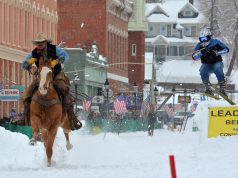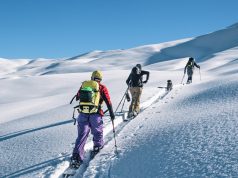
%uFFFD
We start early, as the eastern sun kisses the top of the Flatirons. The air is cool, but the crystalline Colorado sky hints at the heat to come. The valleys are still lush despite the summer. The spring rains lingered late this year, and the trail is still moist. We know we’ll see wildlife on our hike, but we’re not getting an early start in hopes of finding Bambi. Today we’re hunting wildflowers, and Boulder’s grand traverse, the Mesa Trail, promises to serve up a bounty.
%uFFFD
The Mesa Trail is a gem, the big daddy of local hikes.
Other trails may go farther, or be steeper, but none has the allure of the Mesa. Traversing though several different ecosystems and crossing directly underneath Boulder’s most famous landmark — The Flatirons — the Mesa travels 6.7 miles from south to north.
The Mesa is great as a classic “traverse” style hike, running along the lower reaches of the foothills, but it also offers a nearly endless array of options and spur trails. In this sense, the Mesa is the backbone of an extensive system that includes rock climbing access, bird watching, trail running and other activities, like today’s wildflower excursion.
We start at the southern end of the Mesa, appropriately named the South Mesa Trailhead. Accessed via Eldorado Springs Drive (Hwy. 120) from South Broadway (Hwy. 93), it’s in an area that, despite Boulder’s growth, remains relatively rural. The towns here, Marshall and Eldorado Springs, retain a simple vibe, one that harkens back to a time when the surrounding landscape was nearly devoid of homes. While this area has seen growth, the low grassy hills that rise to the west remain protected open space. We’ll travel from this relatively empty landscape to the northern end of the Mesa, finishing our hike in Chautauqua Park, another timeless hamlet of simple cabins. A national historic site, these summer homes are a visible link to Boulder’s past and the historic restaurant the perfect finish to our journey.
Our hike starts, as so many do in Boulder, with a hill. The long climb out of the South Boulder Creek drainage isn’t too tough, though. It’s on a service road, which allows us to chat as we settle into a groove of one foot in front of the other, repeat and then repeat again. The sweeping views distract us from the effort as we climb higher. Our goal is to reach the ponderosa forests and their welcoming shade before the sun climbs higher, along with the temperatures. Along the way we keep an eye out for our prey: wildflowers.
Because of the variety of ecological zones that the Mesa trail traverses, it’s an ideal hike for those who are interested in Colorado’s flora. In drainages and at lower elevations, wild plum, with its white flowers and distinctive bouquet, thrive. Golden banner, with yellow blossoms, add a bit of flash, and white salt and pepper (Lomatium orientale), which is related to the celery family, also can be spotted.
As one climbs into the ponderosa forests, with their open meadows, new types may appear: wild geranium, wild iris and yarrow can be seen blooming along with lupine, one-sided penstemon and bergamot.
And then there are the drainages.
The Mesa crosses over several canyons, including Skunk and Bluebell. These ecosystems feature more moisture and shade than the drier, east-facing meadows, and their hillsides are home to spring beauty, lance-leaved chiming bells and blazing star.
Today, we’ll see some of these flowers, but not all of them. That’s the beauty of wildflower hunting. Some blossoms appear in spring, some in early summer and some, like asters, in mid-July. When you see the asters’ purple blossoms appear, you’ll know that the end of the wildflower season is on the way and it’s time to plan for other adventures, like hiking through golden aspen groves as fall sprinkles the high peaks with snow.
But as the hike levels out and we start heading north, snow isn’t on our mind. The climb and the growing heat of the day have warmed us up, and we’re grateful for the fact that although the Mesa trail does have its ups and downs, effectively we’re contouring across the eastern slope of the Front Range. The traverse makes for fast, easy hiking, and the views, wide open in the glowing morning, are fantastic.
At just under seven miles, this hike won’t take us all day. But that’s the point. Most grand traverses are multi-day affairs. But on the Mesa Trail, we’re blessed to have a grand traverse that — due to the views and the location — is worthy of the name, but easy on the legs and back.
Some water, a few snacks and a decent pair of shoes — that’s enough to get us to our destination: The Chautauqua Dining Hall, which provides another experience that’s almost as grand as the Mesa.
Respond: [email protected]














